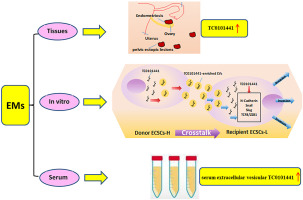当前位置:
X-MOL 学术
›
Exp. Cell Res.
›
论文详情
Our official English website, www.x-mol.net, welcomes your
feedback! (Note: you will need to create a separate account there.)
Extracellular vesicle-mediated transfer of the lncRNA-TC0101441 promotes endometriosis migration/invasion.
Experimental Cell Research ( IF 3.3 ) Pub Date : 2020-01-03 , DOI: 10.1016/j.yexcr.2020.111815 Jun-Jun Qiu 1 , Ying-Ying Lin 2 , Xiao-Yan Tang 1 , Yan Ding 1 , Xiao-Fang Yi 1 , Ke-Qin Hua 1
Experimental Cell Research ( IF 3.3 ) Pub Date : 2020-01-03 , DOI: 10.1016/j.yexcr.2020.111815 Jun-Jun Qiu 1 , Ying-Ying Lin 2 , Xiao-Yan Tang 1 , Yan Ding 1 , Xiao-Fang Yi 1 , Ke-Qin Hua 1
Affiliation

|
Extracellular vesicular long noncoding RNAs (lncRNAs) to influence recipient cells is emerging as a novel mechanism for disease progression. TC0101441 is a newly identified metastasis-related lncRNA involved in cancer. Since endometriosis exhibits prometastasis behavior similar to those observed in cancer, we aimed to investigate whether TC0101441 is involved in endometriosis and, if so, whether extracellular vesicular TC0101441 contributes to the migration/invasion of endometriotic cyst stromal cells (ECSCs). Clinically, we found that TC0101441 was highly expressed in ectopic endometria than in the eutopic and normal endometria. Serum extracellular vesicular TC0101441 levels were substantially increased in patients at stage III/IV endometriosis in comparison with stage I/II endometriosis and controls. In vitro, using TC0101441-high-expression ECSCs (ECSCs-H) as extracellular vesicles (EVs)-generating cells and TC0101441-low-expression ECSCs (ECSCs-L) as recipient cells, we observed that the PKH67-labeled ECSCs-H-derived EVs were effectively internalized by ECSCs-L. ECSCs-H-derived EVs shuttling TC0101441 were transferred to ECSCs-L, modulating their migratory/invasive abilities partially by regulating certain metastasis-related proteins, which eventually facilitated endometriosis migration/invasion. This study elucidates a potential crosstalk between ECSCs via EVs in endometriotic milieus, suggests a novel mechanism for endometriosis migration/invasion from the perspective of the "extracellular vesicular transfer of lncRNAs" and highlights the potential of circulating extracellular vesicular TC0101441 as a biomarker for endometriosis.
中文翻译:

细胞外囊泡介导的lncRNA-TC0101441转移促进子宫内膜异位症的迁移/侵袭。
细胞外水泡长非编码RNA(lncRNA)影响受体细胞正在成为疾病发展的一种新机制。TC0101441是新近鉴定的与癌症有关的与转移相关的lncRNA。由于子宫内膜异位症表现出与癌症中观察到的相似的前转移行为,因此我们旨在研究TC0101441是否与子宫内膜异位症有关,如果是,那么细胞外囊泡TC0101441是否有助于子宫内膜异位症囊肿基质细胞(ECSCs)的迁移/侵袭。临床上,我们发现TC0101441在异位子宫内膜中的表达高于在位和正常子宫内膜中的表达。与I / II期子宫内膜异位症和对照组相比,III / IV期子宫内膜异位症患者的血清细胞外囊泡TC0101441水平显着增加。体外,使用TC0101441高表达ECSC(ECSCs-H)作为细胞外囊泡(EV)生成细胞和TC0101441低表达ECSC(ECSCs-L)作为受体细胞,我们观察到PKH67标记的ECSCs-H衍生的EV被ECSCs-L有效地内部化了。穿梭于TC0101441的ECSCs-H衍生的EV被转移到ECSCs-L,通过调节某些与转移相关的蛋白来部分调节其迁移/侵袭能力,最终促进子宫内膜异位症的迁移/侵袭。这项研究阐明了子宫内膜异位症中通过电动汽车在ECSC之间的潜在串扰,从“ lncRNA的细胞外囊泡转移”的角度提出了子宫内膜异位症迁移/侵入的新机制,并强调了循环的细胞外囊泡TC0101441作为子宫内膜异位症生物标志物的潜力。
更新日期:2020-01-04
中文翻译:

细胞外囊泡介导的lncRNA-TC0101441转移促进子宫内膜异位症的迁移/侵袭。
细胞外水泡长非编码RNA(lncRNA)影响受体细胞正在成为疾病发展的一种新机制。TC0101441是新近鉴定的与癌症有关的与转移相关的lncRNA。由于子宫内膜异位症表现出与癌症中观察到的相似的前转移行为,因此我们旨在研究TC0101441是否与子宫内膜异位症有关,如果是,那么细胞外囊泡TC0101441是否有助于子宫内膜异位症囊肿基质细胞(ECSCs)的迁移/侵袭。临床上,我们发现TC0101441在异位子宫内膜中的表达高于在位和正常子宫内膜中的表达。与I / II期子宫内膜异位症和对照组相比,III / IV期子宫内膜异位症患者的血清细胞外囊泡TC0101441水平显着增加。体外,使用TC0101441高表达ECSC(ECSCs-H)作为细胞外囊泡(EV)生成细胞和TC0101441低表达ECSC(ECSCs-L)作为受体细胞,我们观察到PKH67标记的ECSCs-H衍生的EV被ECSCs-L有效地内部化了。穿梭于TC0101441的ECSCs-H衍生的EV被转移到ECSCs-L,通过调节某些与转移相关的蛋白来部分调节其迁移/侵袭能力,最终促进子宫内膜异位症的迁移/侵袭。这项研究阐明了子宫内膜异位症中通过电动汽车在ECSC之间的潜在串扰,从“ lncRNA的细胞外囊泡转移”的角度提出了子宫内膜异位症迁移/侵入的新机制,并强调了循环的细胞外囊泡TC0101441作为子宫内膜异位症生物标志物的潜力。











































 京公网安备 11010802027423号
京公网安备 11010802027423号